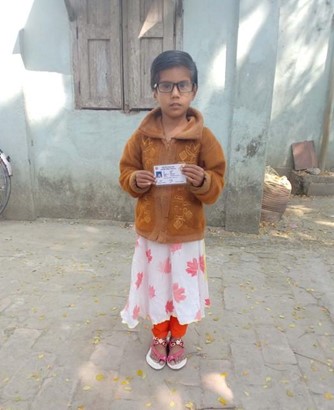
Noori, a 10-year-old student with deafblindness from Jashore District in Bangladesh, is holding her Subarna Nagorik Card, Disability ID card, where deafblindness is specifically mentioned.
Courtesy of National Resource Centre on Deafblindness (NRCDB) and Centre for Disability in Development (CDD).
There are a range of social protection supports for persons with disabilities in Bangladesh, including a disability pension of 750 Bangladeshi taka per month. There is also a smaller student stipend based on the number of students per household. In addition, tailored supports are linked to the social protection system, such as supports in education. These social protection measures are essential for persons with deafblindness, as many live below the poverty line and because of the extra costs of having a disability.
To access social protection measures and other tailored supports, persons with disabilities must be certified by a doctor and apply for a Disability Identification (ID) card, which is issued by the Department of Social Services.
Deafblindness was not legally recognised until 2013 in Bangladesh, and as a result, most persons with deafblindness were inaccurately categorised as having ‘multiple disabilities’ on their Disability ID cards. The Centre for Disability in Development (CDD) in partnership with Sense International began advocating for deafblindness to be recognised as a distinct disability in 2007, and under the Disability Act of 2013, deafblindness was finally recognised as a distinct disability.
This did not lead to immediate changes for persons with deafblindness because many people, including social workers and government officials, still thought of deafblindness as a condition of multiple disabilities rather than a distinct disability. Now that deafblindness is recognised on ID cards, persons with deafblindness are better able to advocate for tailored supports, which was very difficult to do with the categorisation of “multiple disabilities”. For example, a student with deafblindness who has an ID card listing deafblindness may be in a better position to request to learn deafblind communication methods and receive communication supports in school than a student with deafblindness who has an ID card listing “multiple disabilities”.
CDD aimed to increase awareness so that deafblindness as a distinct disability could be better integrated and utilised within the social protection system and to ensure that social protection benefits match the requirements of persons with deafblindness.
With support from Sense International, CDD trained social service officers in eight districts, since they are the entry point for issuing Disability ID cards and social protection benefits. Slowly, persons with deafblindness have been recognised through the ID cards.
This has led to concrete steps in improved support for persons with deafblindness. For example, during the COVID-19 pandemic, persons with deafblindness were given priority during relief (i.e., distribution of basic food items, hygiene kits, and financial support) because social service officials were sensitised and because persons with deafblindness were easier to identify. At the community level, there is greater awareness of deafblindness and improvements in identifying deafblindness and understanding the condition, including among teachers. Furthermore, as the disability movement in Bangladesh advocates for the introduction of standardised tailored supports for each disability, persons with deafblindness are more likely to be included in government plans because there is increasing data on persons with deafblindness through the ID card scheme.
Many challenges remain. For example, persons with deafblindness who have ID cards listing ‘multiple disabilities’ need to be better informed on how to change their status to ‘deafblindness’ and the benefits of doing so. Family members, doctors, and social service officials require continuous sensitisation on the importance of deafblindness as a distinct disability, the link between disability status on ID cards and the eligibility of social protection measures, and their role in facilitating the process. In addition, the disability pension and student stipend need to be increased, particularly for people with high or complex needs.
Nevertheless, CDD has demonstrated that ‘one size does not fit all’ regarding social protection mechanisms, and that there is a link between legal recognition of deafblindness, understanding of deafblindness, its importance as a distinct disability, and access to tailored social protection supports.